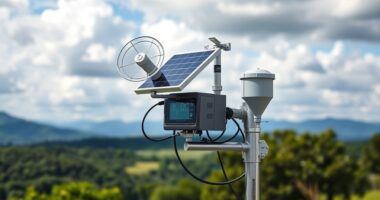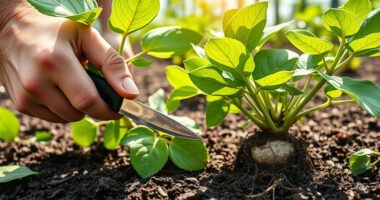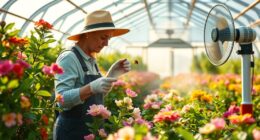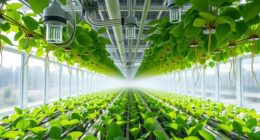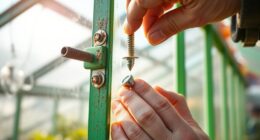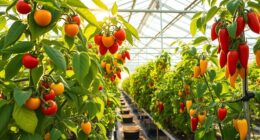Hydroponics in greenhouses lets you grow crops all year round by creating the perfect environment for plant health. You can save up to 80% water compared to traditional farming, and enjoy higher yields with less space. Key components like effective lighting, balanced nutrient solutions, and climate control systems help manage growth. With various hydroponic systems available, you can maximize efficiency and sustainability. Stick around to discover more about the benefits and setup of hydroponic greenhouses.
Key Takeaways
- Hydroponics in greenhouses allows for year-round crop production by controlling optimal growing conditions.
- This method uses up to 90% less water compared to traditional soil farming techniques.
- Hydroponic systems enhance plant growth with precise nutrient delivery and climate control.
- Greenhouses provide a barrier against pests and diseases, promoting healthier crops.
- Various hydroponic systems, like NFT and DWC, offer flexible options for efficient nutrient management.
Benefits of Hydroponics in Greenhouses
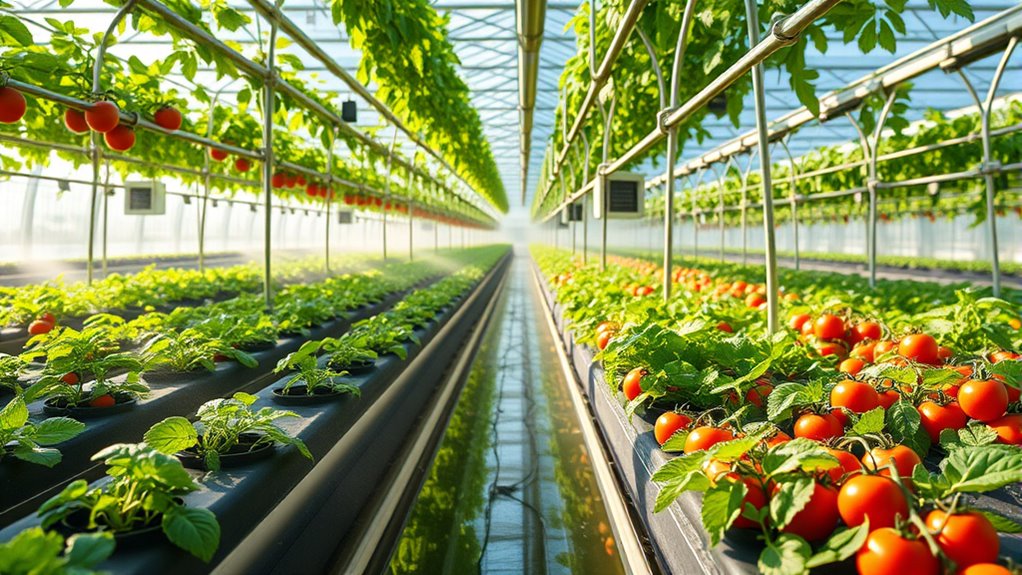
When you choose hydroponics in greenhouses, you unlock a range of benefits that can transform your approach to gardening.
This method enables year-round production by controlling the ideal conditions for your plants, regardless of the weather outside.
You'll enjoy enhanced pest protection, as greenhouses provide a barrier against common pests, reducing the need for harmful chemicals.
With precise climate control, you can manage temperature, humidity, and light effectively, leading to healthier, faster-growing plants.
Precise climate control fosters optimal growth conditions, ensuring your plants thrive with increased health and speed.
Hydroponics also uses up to 80% less water than traditional methods, maximizing space and minimizing maintenance. Additionally, the use of nutrient solutions ensures that plants receive essential minerals directly, promoting faster growth and higher yields.
Key Components of Hydroponic Greenhouses

Hydroponic greenhouses are intricate systems designed to maximize plant growth and efficiency. Key components include effective lighting systems, like HPS, MH, and energy-efficient LEDs, ensuring plants receive adequate light for photosynthesis. Proper lighting essential for photosynthesis ensures healthy plant growth.
Choosing the right growing medium, such as rockwool or coconut coir, supports healthy root development. Balanced nutrient solutions, containing essential macronutrients and micronutrients, are crucial for optimal plant health.
Popular hydroponic systems like deep water culture or nutrient film technique facilitate nutrient delivery. Climate control systems manage temperature and humidity, preventing disease and stress.
These components work together to create a thriving environment, enabling you to grow plants all year round, regardless of external conditions.
Setting Up a Hydroponic Greenhouse
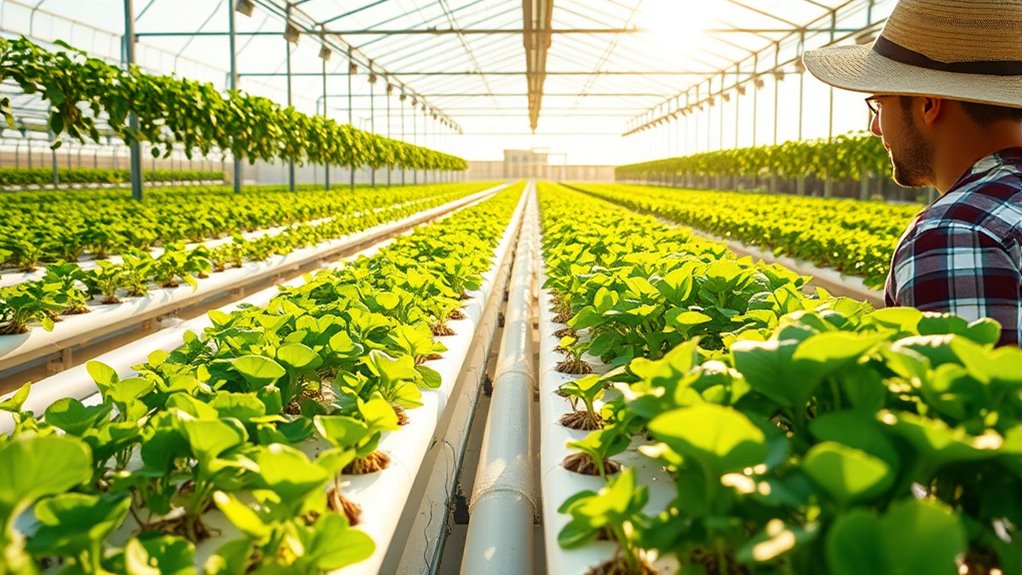
Creating a hydroponic greenhouse involves careful planning and execution to ensure a productive growing environment. Start by cleaning and sanitizing the space to eliminate pests and diseases. Make sure the greenhouse structure is sturdy enough to withstand weather conditions.
Next, set up proper ventilation with vents and fans to maintain airflow and temperature. Assess natural light availability and consider adding LED lights for supplemental illumination. Hydroponics uses less water compared to conventional farming, making it an ideal choice for sustainable agriculture in a greenhouse setting.
Choose the right equipment, including nutrient delivery systems and clean water reservoirs. Install pumps and timers for efficient water circulation.
Finally, prepare your hydroponic system by selecting suitable containers, mixing your nutrient solution, and placing plant starts in mesh pots. Run a trial to verify that everything functions correctly before planting.
Types of Hydroponic Systems

While exploring hydroponics, you'll find various systems tailored to meet different growing needs.
Liquid hydroponic systems, like Nutrient Film Technique (NFT) and Deep Water Culture (DWC), continuously deliver nutrients to plants. Floating hydroponics allows plants to thrive on rafts in nutrient solutions, while aeroponics suspends roots in air and mists them. Aggregate systems, such as rockwool and gravel culture, support plants with inert media. Active systems, including drip and Ebb and Flow, ensure precise nutrient delivery. Passive systems like the wick method utilize capillary action. Hybrid systems combine methods for improved efficiency, while vertical towers and Dutch Buckets enhance space utilization. Each system offers unique advantages, making hydroponics a specialized form of agriculture versatile for greenhouse growers.
Advantages Over Traditional Methods

When comparing hydroponics to traditional gardening methods, you'll quickly notice several compelling advantages that make hydroponics a game-changer.
First, hydroponics uses up to 90% less water, allowing for significant conservation, especially in water-scarce areas.
Hydroponics conserves up to 90% more water, making it an ideal choice for sustainable gardening in water-scarce regions.
You'll also benefit from enhanced crop yields, with potential increases of up to 50% per unit area, thanks to optimized nutrient delivery and vertical farming techniques. Additionally, the more efficient water use in hydroponics means that you can produce more food while conserving precious resources.
The controlled environment of hydroponics minimizes pest infestations and soil-borne diseases, reducing the need for pesticides.
This method maximizes space and resource efficiency, allowing you to grow more plants in less area without the hassle of soil maintenance.
Ultimately, hydroponics supports sustainable agricultural practices while providing consistent, reliable harvests year-round.
Challenges and Considerations

Although hydroponics offers numerous benefits, it also presents a unique set of challenges and considerations that you need to navigate for successful implementation.
Nutrient management is crucial; maintaining the right balance and monitoring pH levels is essential to avoid deficiencies or toxicities. Continuous monitoring ensures sustainable nutrient management, allowing for adjustments based on crop-specific requirements.
Environmental control adds complexity too; you'll need effective systems to manage temperature, humidity, and airflow, all while considering energy consumption.
Pest and disease management requires diligence, as pathogens can spread quickly without proper precautions.
Additionally, water quality and conservation are vital; closed-loop systems can optimize usage but require regular monitoring.
Lastly, be prepared for the initial investment and continuous training to ensure you have the necessary expertise to manage this advanced growing method effectively.
Frequently Asked Questions
What Crops Are Best Suited for Hydroponic Systems?
When you're choosing crops for hydroponic systems, focus on fast-growing leafy greens like lettuce, spinach, and kale.
Herbs such as basil and mint thrive in these environments too.
For fruiting plants, cherry tomatoes and alpine strawberries are excellent picks.
Peppers and cucumbers also perform well.
Don't forget quick-growing options like radishes and microgreens, which are perfect for beginners.
These crops not only adapt well but also yield high returns in a controlled setup.
How Do I Prevent Algae Growth in My Hydroponic System?
To prevent algae growth in your hydroponic system, keep temperatures below 77°F (25°C) and maintain slightly acidic pH levels.
Block light from entering the system, as algae need light to thrive. Lower humidity and improve ventilation to keep surfaces dry.
Use mechanical and biological filtration, and regularly clean your equipment.
Consider adding diluted hydrogen peroxide or beneficial bacteria to outcompete algae for nutrients and ensure your reservoirs are covered with opaque materials.
Can Hydroponics Be Used for Fruits and Vegetables?
Absolutely! Hydroponics can be your go-to method for growing fruits and vegetables.
Think of it as gardening on steroids—you're looking at enhanced yields and faster growth rates. You can cultivate everything from leafy greens to juicy tomatoes year-round, all while saving water and minimizing land use.
Plus, you control the nutrients, ensuring your produce is nutrient-dense and free from harmful chemicals.
What Is the Lifespan of a Hydroponic System?
The lifespan of a hydroponic system can vary based on your maintenance and the materials used.
Generally, with proper care, a well-maintained system can last several years.
You'll need to regularly monitor nutrient levels, pH, and sterilize components to prevent issues.
While the plants may have specific lifespans, the system itself can remain functional as long as you stay on top of upkeep and address any technical challenges that arise.
How Do I Troubleshoot Common Hydroponic System Issues?
Did you know that nearly 60% of hydroponic growers face pest issues at some point?
To troubleshoot common hydroponic system problems, start by inspecting for pests like aphids or spider mites.
Check your nutrient balance and pH levels regularly to prevent deficiencies.
Ensure your system's clean and free of clogs by maintaining pumps and tubing.
Lastly, monitor temperature and humidity to create an optimal environment for your plants' growth.
Conclusion
In the world of wondrous weed cultivation, hydroponics in greenhouses offers a fantastic fusion of efficiency and innovation. You'll discover delightful delights, from faster growth to fewer pests, all while saving precious resources. As you embark on this exciting experiment, remember to weigh the challenges and conquer them with care. Dive into the dynamic domain of hydroponics, and you'll transform your gardening game into a flourishing success story that's simply sensational!




